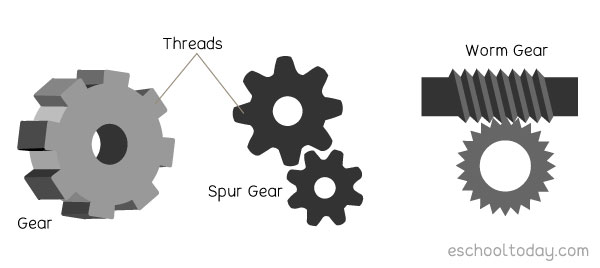- Simple Machines
Gears
A gear is simply a special wheel with teeth on the outside. Gears are usually arranged in more than one wheel. They are arranged with their teeth interlocking. The combination can include small and large wheels. When one wheel is in motion, it transfers its motion and force to the connected wheel by moving its teeth. Larger wheels turn slower than smaller wheels. Two wheels with meshed teeth always turn in the opposite direction.
Gears come in many forms and perform many specific functions.
Two very common types include the Spur Gear and the Worm Gear.

Spur Gear:
It is a disc with threads on it. When the threads of two spur gears are fixed parallel to each other, the circular movement of one transmits motion and power efficiently into the other gear.
Worm Gear:
A worm gear looks like a screw but with no head and tip. The thread on the shaft connects with a spur gear. Just like two spur gears in action, the movement of the worm gear powers the movement of the spur gear. You can use gears to slow things down, speed them up, change direction, and do more tasks at the same time. Gears can be used to increase force or increase speed but not both. An example is the gears on a bicycle. As you pedal up a hill, you can change the gears to give you more power, but that will slow the bike down.
You can also change gears to give you speed, but that means you will need strong legs to push the pedal.
